Projected Changes in Extreme Temperature and Precipitation Indices Over CORDEX-MENA Domain
Abstract
:1. Introduction
2. Materials and Methods
3. Results
3.1. Temperature Indices
3.1.1. Absolute and Threshold Indices
3.1.2. Duration Indices
3.1.3. Percentile Indices
3.2. Precipitation Indices
4. Discussion and Conclusions
Supplementary Materials
Author Contributions
Funding
Data Availability Statement
Conflicts of Interest
References
- Nicholls, N.; Alexander, L. Has the climate become more variable or extreme? Progress 1992–2006. Prog. Phys. Geogr. 2007, 31, 77–87. [Google Scholar] [CrossRef]
- Sillmann, J.; Kharin, V.; Zwiers, F.; Zhang, X.; Bronaugh, D. Climate extremes indices in the CMIP5 multimodel ensemble: Part 2. Future climate projections. J. Geophys. Res. Atmos. 2013, 118, 2473–2493. [Google Scholar] [CrossRef]
- Zwiers, F.W.; Alexander, L.V.; Hegerl, G.C.; Knutson, T.R.; Kossin, J.; Naveau, P.; Nicholls, N.; Schar, C.; Seneviratne, S.I.; Zhang, X. Climate Extremes: Challenges in estimating and understanding recent changes in the frequency and intensity of extreme climate and weather events. In Climate Science for Serving Society: Research, Modelling and Prediction Priorities; Asrar, G.R., Hurrell, J.W., Eds.; Springer: Dordrecht, The Netherlands, 2013. [Google Scholar]
- IPCC. Managing the Risks of Extreme Events and Disasters to Advance Climate Change Adaptation. A Special Report of Working Groups I and II of the Intergovernmental Panel on Climate Change; Cambridge University Press: Cambridge, UK; New York, NY, USA, 2012; p. 582. [Google Scholar] [CrossRef]
- Chen, H.; Sun, J. Assessing model performance of climate extremes in China: An intercomparison between CMIP5 and CMIP3. Clim. Change 2015, 129, 197–211. [Google Scholar] [CrossRef]
- Karl, T.; Easterling, D. Climate extremes: Selected review and future research directions. Clim. Change 1999, 42, 309–325. [Google Scholar] [CrossRef]
- Klein Tank, A.M.G.; Zwiers, F.W.; Zhang, X. Guidelines on analysis of extremes in a changing climate in support of informed decisions for adaptation. In Climate Data and Monitoring WCDMP-No. 72, WMO-TD No. 1500; World Meteorological Organization: Geneva, Switzerland, 2009; p. 56. [Google Scholar]
- Zhang, X.; Alexander, L.; Hegerl, G.C.; Jones, P.; Tank, A.K.; Peterson, T.C.; Trewin, B.; Zwiers, F.W. Indices for monitoring changes in extremes based on daily temperature and precipitation data. Wiley Interdiscip. Rev. Clim. Chang. 2011, 2, 851–870. [Google Scholar] [CrossRef]
- Alexander, L.V.; Zhang, X.; Peterson, T.C.; Caesar, J.; Gleason, B.; Tank, A.M.G.K.; Haylock, M.; Collins, D.; Trewin, B.; Rahimzadeh, F.; et al. Global observed changes in daily climate extremes of temperature and precipitation. J. Geophys. Res. 2006, 111. [Google Scholar] [CrossRef] [Green Version]
- Donat, M.G.; Alexander, L.V.; Yang, H.; Durre, I.; Vose, R.; Dunn, R.J.H.; Willett, K.M.; Aguilar, E.; Brunet, M.; Caesar, J.; et al. Updated analyses of temperature and precipitation extreme indices since the beginning of the twentieth century: The HadEX2 dataset. J. Geophys. Res. Atmos. 2013, 118, 2098–2118. [Google Scholar] [CrossRef]
- Kharin, V.V.; Zwiers, F.W.; Zhang, X.; Hegerl, G.C. Changes in temperature and precipitation extremes in the IPCC ensemble of global coupled model simulations. J. Clim. 2007, 20, 1419–1444. [Google Scholar] [CrossRef] [Green Version]
- Sillmann, J.; Kharin, V.V.; Zhang, X.; Zwiers, F.W.; Bronaugh, D. Climate extremes indices in the CMIP5 multimodel ensemble: Part 1. Model evaluation in the present climate. J. Geophys. Res. Atmos. 2013, 118, 1716–1733. [Google Scholar] [CrossRef]
- Frich, P.; Alexander, L.; Della-Marta, P.; Gleason, B.; Haylock, M.; Klein Tank, A.; Peterson, T. Observed coherent changes in climate extremes during the second half of the twentieth century. Clim. Res. 2002, 19, 193–212. [Google Scholar] [CrossRef] [Green Version]
- Ntoumos, A.; Hadjinicolaou, P.; Zittis, G.; Lelieveld, J. Updated Assessment of Temperature Extremes over the Middle East–North Africa (MENA) Region from Observational and CMIP5 Data. Atmosphere 2020, 11, 813. [Google Scholar] [CrossRef]
- Sillmann, J.; Roeckner, E. Indices for extreme events in projections of anthropogenic climate change. Clim. Change 2008, 86, 83–104. [Google Scholar] [CrossRef] [Green Version]
- Orlowsky, B.; Seneviratne, S. Global changes in extremes events: Regional and seasonal dimension. Clim. Change 2012, 110, 669–696. [Google Scholar] [CrossRef] [Green Version]
- Chen, H.; Sun, J.Q. Projection and uncertainty analysis of global precipitation-related extremes using CMIP5 models. Int. J. Climatol. 2014, 34, 2730–2748. [Google Scholar] [CrossRef]
- Kharin, V.; Zwiers, F.; Zhang, X.; Wehner, M.F. Changes in temperature and precipitation extremes in the CMIP5 ensemble. Clim. Change 2013, 119, 345–357. [Google Scholar] [CrossRef]
- Chen, C.; Knutson, T. On the Verification and Comparison of Extreme Rainfall Indices from Climate Models. J. Clim. 2008, 21, 1605–1621. [Google Scholar] [CrossRef]
- Alexander, L.; Arblaster, J.M. Assessing trends in observed and modelled climate extremes over Australia in relation to future projections. Int. J. Clim. 2007, 29, 417–435. [Google Scholar] [CrossRef]
- Peterson, T.; Zhang, X.; Brunet-India, M.; Vázquez-Aguirre, J. Changes in North American extremes derived from daily weather data. J. Geophys. Res. 2008, 113. [Google Scholar] [CrossRef] [Green Version]
- Thibeault, J.M.; Seth, A. Changing climate extremes in the Northeast United States: Observations and projections from CMIP5. Clim. Change 2014, 127, 273–287. [Google Scholar] [CrossRef]
- Scherer, M.; Diffenbaugh, N. Transient twenty-first century changes in daily-scale temperature extremes in the United States. Clim. Dyn. 2013, 42, 1383–1404. [Google Scholar] [CrossRef]
- Gao, X.; Giorgi, F. Increased aridity in the Mefiterranean region under greenhouse gas forcing estimated from high resolution simulations with a regional climate model. Glob. Planet. Change 2008, 62, 195–209. [Google Scholar] [CrossRef]
- Vincent, L.A.; Aguilar, E.; Saindou, M.; Hassane, A.; Jumaux, G.; Roy, D.; Booneeady, P.; Virasami, R.; Randriamarolaza, L.; Faniriantsoa, F.R.; et al. Observed trends in indices of daily and extreme temperature and precipitation for the countries of the western Indian Ocean, 1961–2008. J. Geophys. Res. 2011, 116. [Google Scholar] [CrossRef]
- Donat, M.G.; Peterson, T.C.; Brunet, M.; King, A.D.; Almazroui, M.; Kolli, R.K.; Boucherf, D.; Al-Mulla, A.Y.; Nour, A.Y.; Aly, A.A.; et al. Changes in extreme temperature and precipitation in the Arab region: Long-term trends and variability related to ENSO and NAO. Int. J. Climatol. 2013. [Google Scholar] [CrossRef]
- You, Q.; Kang, S.; Aguilar, E.; Yan, Y. Changes in daily climate extremes in the eastern and central Tibetan Plateau during 1961–2005. J. Geophys. Res. 2008, 113. [Google Scholar] [CrossRef] [Green Version]
- Fan, X.; Wang, Q.; Wang, M. Changes in temperature and precipitation extremes during 1959–2008 in Shanxi, China. Theor. Appl. Climatol. 2012, 109, 283–303. [Google Scholar] [CrossRef]
- Soltani, M.; Laux, P.; Kunstmann, H.; Stan, K.; Sohrabi, M.M.; Molanejad, M.; Sabziparvar, A.A.; SaadatAbadi, A.R.; Ranjbar, F.; Rousta, I.; et al. Assessment of climate variations in temperature and precipitation extreme events over Iran. Theor. Appl. Climatol. 2015, 126, 775–795. [Google Scholar] [CrossRef] [Green Version]
- Roushdi, M.; Mostafa, H.; Kheireldin, K. Present and Future Climate Extreme Indices over Sinai Peninsula, Egypt. Int. J. Geol. Environ. Eng. 2016, 10, 85–90. [Google Scholar] [CrossRef]
- Tank, A.K.; Peterson, T.; Quadir, D.; Dorji, S.; Zou, X.; Tang, H.; Santhosh, K.; Joshi, U.; Jaswal, A.; Kolli, R.K.; et al. Changes in daily temperature and precipitation extremes in Central and South Asia. J. Geophys. Res. 2006, 111. [Google Scholar] [CrossRef]
- Lee, Y.; Paek, J.; Park, J.S.; Boo, K.O. Changes in temperature and rainfall extremes across East Asia in the CMIP5 ensemble. Theor. Appl. Climatol. 2020. [Google Scholar] [CrossRef]
- Berhane, A.; Hadgu, G.; Worku, W.E.A. Trends in extreme temperature and rainfall indices in the semi-arid areas of Western Tigray, Ethiopia. Environ. Syst. Res. 2020, 9. [Google Scholar] [CrossRef] [Green Version]
- Shawul, A.; Chakma, S. Trend of extreme precipitation indices and analysis of long-term climate variability in the Upper Awash basin, Ethiopia. Theor. Appl. Climatol. 2020, 140, 635–652. [Google Scholar] [CrossRef]
- Degefu, M.; Tadesse, Y.; Bewket, W. Observed changes in rainfall amount and extreme events in southeastern Ethiopia, 1955–2015. Theor. Appl. Climatol. 2021, 144, 967–983. [Google Scholar] [CrossRef]
- Islam, M.N.; Almazroui, M.; Dambul, R.; Jones, P.D.; Alamoudi, A.O. Long-term changes in seasonal temperature extremes over Saudi Arabia during 1981–2010. Int. J. Climatol. 2015, 35. [Google Scholar] [CrossRef]
- Min, S.K.; Zhang, X.; Zwiers, F.W.; Hegerl, G. Human contribution to more-intense precipitation extremes. Nature 2010, 470, 378–381. [Google Scholar] [CrossRef] [PubMed]
- Morak, S.; Hegerl, G.; Christidis, N. Detectable Changes in the Frequency of Temperature Extremes. J. Clim. 2013, 26, 1561–1574. [Google Scholar] [CrossRef] [Green Version]
- Fischer, E.; Knutti, R. Detection of spatially aggregated changes in temperature and precipitation extremes. Geophys. Res. Lett. 2014, 41, 547–554. [Google Scholar] [CrossRef]
- Kharin, V.V.; Zwiers, F.W. Changes in the extremes in an ensemble of transient climate simulations with a coupled atmosphere–ocean GCM. J. Clim. 2000, 13, 3760–3788. [Google Scholar] [CrossRef]
- Kharin, V.V.; Zwiers, F.W. Estimating extremes in transient climate change simulations. J. Clim. 2005, 18, 1156–1173. [Google Scholar] [CrossRef]
- Semenov, V.A.; Bengtsson, L. Secular trends in daily precipitation characteristics: Greenhouse gas simulation with a coupled AOGCM. Clim. Dyn. 2002, 19, 123–140. [Google Scholar]
- Voss, R.; May, W.; Roeckner, E. Enhanced resolution modelling study on anthropogenic climate change: Changes in extremes of the hydrological cycle. Int. J. Climatol. 2002, 22, 755–777. [Google Scholar] [CrossRef]
- Wilby, R.L.; Wigley, T.M.L. Future changes in the distribution of daily precipitation totals across North America. Geophys. Res. Lett. 2002, 29, 1135. [Google Scholar] [CrossRef]
- Lee, J.W.; Hong, S.Y.; Chang, E.C.; Suh, M.S.; Kang, H.S. Assessment of future climate change over East Asia due to the RCP scenarios downscaled by GRIMs-RMP. Clim. Dyn. 2014, 42, 733–747. [Google Scholar] [CrossRef]
- Murphy, J.M.; Mitchell, J.F.B. Transient response of the Hadley Centre coupled ocean-atmosphere model to increasing carbon dioxide. Part II: Spatial and temporal structure of response. J. Clim. 1995, 8, 57–80. [Google Scholar] [CrossRef] [Green Version]
- Giorgi, F.; Hewitson, B. Regional climate information–evaluation and projections. In Climate Change: The Scientific Basis, Contribution of Working Group I to the Third Assessment Report; Cambridge University Press: Cambridge, UK, 2001. [Google Scholar]
- Jones, R.G.; Noguer, M.; Hassell, D.C. Generating High–Resolution Climate Change Scenarios Using PRECIS; Met Office Hadley Centre: Exeter, UK, 2004. [Google Scholar]
- Almazroui, M. Temperature Changes over the CORDEX-MENA Domain in the 21st Century Using CMIP5 Data Downscaled with RegCM4: A Focus on the Arabian Peninsula. Clim. Dyn. 2019, 2019. [Google Scholar] [CrossRef] [Green Version]
- Ozturk, T.; Turp, M.; Türkeş, M.; Kurnaz, M. Future projections of temperature and precipitation climatology for CORDEX- MENA domain using RegCM4.4. Atmos. Res. 2018, 206, 87–107. [Google Scholar] [CrossRef]
- Demiroglu, O.C.; Saygili-Araci, F.S.; Pacal, A.; Hall, C.M.; Kurnaz, M.L. Future Holiday Climate Index (HCI) Performance of Urban and Beach Destinations in the Mediterranean. Atmosphere 2020, 11, 911. [Google Scholar] [CrossRef]
- Endris, H.S.; Lennard, C.; Hewitson, B.; Dosio, A.; Nikulin, G.; Panitz, H.J. Teleconnection responses in multi-GCM driven CORDEX RCMs over Eastern Africa. Clim. Dyn. 2015. [Google Scholar] [CrossRef]
- Almazroui, M.; Islam, M.N.; Alkhalaf, A.K.; Saeed, F.; Dambul, R.; Rahman, M.A. Simulation of temperature and precipitation climatology for the CORDEX-MENA/Arab domain using RegCM4. Arab. J. Geosci. 2016, 9. [Google Scholar] [CrossRef]
- Vuuren, D.; Edmonds, J.; Kainuma, M.; Riahi, K.; Thomson, A.; Hibbard, K.; Hurtt, G.; Kram, T.; Krey, V.; Lamarque, J.F.; et al. The representative concentration pathways: An overview. Clim. Change 2011, 109, 5–31. [Google Scholar] [CrossRef]
- Rogelj, J.; Meinshausen, M.; Knutti, R. Global warming under old and new scenarios using IPCC climate sensitivity range estimates. Nat. Clim. Change 2012, 2, 248–253. [Google Scholar] [CrossRef]
- World Bank. Water in the Arab world: From Droughts to Flood, Building Resilience Against Extremes. 2014. Available online: https://www.worldbank.org/en/news/feature/2014/03/20/floods-and-droughts-in-mena (accessed on 11 March 2021).
- World Bank. Beyond Scarcity: Water Security in the Middle East and North Africa. MENA Development Report. 2017. Available online: https://openknowledge.worldbank.org/bitstream/handle/10986/27659/211144ov.pdf (accessed on 11 March 2021).
- Waha, K.; Krummenauer, L.; Adams, S.; Aich, V.; Baarsch, F.; Coumou, D.; Fader, M.; Hoff, H.; Jobbins, G.; Marcus, R.; et al. Climate change impacts in the Middle East and Northern Africa (MENA) region and their implications for vulnerable population groups. Reg. Environ. Change 2017, 17, 1623–1638. [Google Scholar] [CrossRef]
- Najem, S.; Bitar, A.A.; Faour, G.; Jarlan, L.; Mhawej, M.; Fadel, A.; Zribi, M. Drought Assessment using Micro-Wave Timeseries of Precipitation and Soil Moisture Over the Mena Region. In Proceedings of the 2020 Mediterranean and Middle-East Geoscience and Remote Sensing Symposium (M2GARSS), Tunis, Tunisia, 9–11 March 2017. [Google Scholar] [CrossRef]
- Stocker, T.F.; Qin, D.; Plattner, G.-K.; Tignor, M.; Allen, S.K.; Boschung, J.; Nauels, A.; Xia, Y.; Bex, V.; Midgley, P.M. (Eds.) Climate Change 2013. The Physical Science Basis. Contribution of Working Group I to the Fifth Assessment Report of the Intergovernmental Panel on Climate Change; Cambridge University Press: Cambridge, UK; New York, NY, USA, 2014. [Google Scholar] [CrossRef] [Green Version]
- Cook, B.; Mankin, J.; Anchukaitis, K. Climate Change and Drought: From Past to Future. Curr. Clim. 2018, 4, 164–179. [Google Scholar] [CrossRef]
- Seneviratne, S.I.; Nicholls, N.; Easterling, D.R.; Goodess, C.M.; Kanae, S.; Kossin, J.P.; Luo, Y.; A Marengo, J.; McInnes, K.L.; Rahimi, M.; et al. Changes in climate extremes and their impacts on the natural physical environment. In Managing the Risks of Extreme Events and Disasters to Advance Climate Change Adaptation; Special Report of the Intergovernmental Panel on Climate Change; Cambridge University Press: Cambridge, UK; New York, NY, USA, 2002; pp. 109–230. [Google Scholar]
- Loudyi, D.; Kantoush, S. Flood risk management in the Middle East and North Africa (MENA) region. Urban Water J. 2020, 17, 379–380. [Google Scholar] [CrossRef]
- Zhang, X.; Aguilar, E.; Şensoy, S.; Melkonyan, H.; Tagiyeva, U.; Ahmed, N.M.; Kutaladze, N.; Rahimzadeh, F.; Taghipour, A.; Hantosh, T.H.; et al. Trends in Middle East climate extreme indices from 1950 to 2003. J. Geophys. Res. 2005, 110. [Google Scholar] [CrossRef]
- Lelieveld, J.; Proestos, Y.; Hadjinicolaou, P.; Tanarhte, M.; Tyrlis, E.; Zittis, G. Strongly increasing heat extremes in the Middle East and North Africa (MENA) in the 21st century. Clim. Change 2016, 137. [Google Scholar] [CrossRef] [Green Version]
- Almazroui, M.; Saeed, F.; Saeed, S.; Islam, M.N.; Ismail, M.; Klutse, N.A.B.; Siddiqui, M.H. Projected Change in Temperature and Precipitation Over Africa from CMIP6. Earth. Syst. Environ. 2020, 4. [Google Scholar] [CrossRef]
- Van Vuuren, D.P.; Riahi, K.; Calvin, K.; Dellink, R.; Emmerling, J.; Fujimori, S.; KC, S.; Kriegler, E.; O’Neill, B. The Shared Socio-economic Pathways: Trajectories for human development and global environmental change. Glob. Environ. Change 2017, 42, 148–152. [Google Scholar] [CrossRef] [Green Version]
- Riahi, K.; van Vuuren, D.P.; Kriegler, E.; Edmonds, J.; O’Neill, B.C.; Fujimori, S.; Bauer, N.; Calvin, K.; Dellink, R.; Fricko, O.; et al. The Shared Socioeconomic Pathways and their energy, land use, and greenhouse gas emissions implications: An overview. Glob. Environ. Change 2017, 42, 153–168. [Google Scholar] [CrossRef] [Green Version]
- Kriegler, E.; Bauer, N.; Popp, A.; Humpenöder, F.; Leimbach, M.; Strefler, J.; Baumstark, L.; Bodirsky, B.L.; Hilaire, J.; Klein, D.; et al. Fossil-fueled development (SSP5): An energy and resource intensive scenario for the 21st century. Glob. Environ. Change 2017, 42, 297–315. [Google Scholar] [CrossRef] [Green Version]
- Driouech, F.; ElRhaz, K.; Moufouma-Okia, W.; Arjdal, K.; Balhane, S. Assessing Future Changes of Climate Extreme Events in the CORDEX-MENA Region Using Regional Climate Model ALADIN-Climate. Earth Syst. Environ. 2020, 4, 477–492. [Google Scholar] [CrossRef]
- Spinoni, J.; Barbosa, P.; Bucchignani, E.; Cassano, J.; Cavazos, T.; Christensen, J.H.; Christensen, O.B.; Coppola, E.; Evans, J.; Geyer, B.; et al. Future Global Meteorological Drought Hot Spots: A Study Based on CORDEX Data. J. Clim. 2020, 33, 3635–3661. [Google Scholar] [CrossRef]
- Zittis, G.; Hadjinicolaou, P.; Almazroui, M.; Bucchignani, E.; Driouech, F.; El Rhaz, K.; Kurnaz, M.L.; Nikulin, G.; Ntoumos, A.; Ozturk, T.; et al. Business-as-usual will lead to super and ultra-extreme heatwaves in the Middle East and North Africa. NPJ Clim. Atmos. Sci. 2021, 4, 20. [Google Scholar] [CrossRef]
- Giorgi, F.; Coppola, E.; Solmon, F.; Mariotti, L.; Sylla, M.B.; Bi, X.; Elguindi, N.; Diro, G.T.; Nair, V.; Giuliani, G.; et al. RegCM4: Model description and preliminary tests over multiple CORDEX domains. Clim. Res. 2012, 52, 7–29. [Google Scholar] [CrossRef] [Green Version]
- Tebaldi, C.; Hayhoe, K.; Arblaster, J.; Meehl, G. Going to the extremes: An intercomparison of modelsimulated historical and future changes in extreme events. Clim. Change 2006, 79, 185–211. [Google Scholar] [CrossRef]
- Terando, A.; Keller, K.; Easterling, W.E. Probabilistic projections of agro-climate indices in North America. J. Geophys. Res. 2012, 117. [Google Scholar] [CrossRef] [Green Version]
- Patz, J.A.; Campbell-Lendrum, D.; Holloway, T.; Foley, J.A. Impact of regional climate change on human health. Nat. Rev. 2005, 438, 310–317. [Google Scholar] [CrossRef]
- Cardona, O.; van Aalst, M.; Birkmann, J.; Fordham, M.; McGregor, G.; Perez, R.; Pulwarty, R.; Schipper, E.; Sinh, B. Determinants of risk: Exposure and vulnerability. In Managing the Risks of Extreme Events and Disasters to Advance Climate Change Adaptation; A Special Report of Working Groups I and II of the Intergovernmental Panel on Climate Change (IPCC); Cambridge University Press: Cambridge, UK; New York, NY, USA, 2012; pp. 65–108. [Google Scholar]
- Giorgi, F.; Francisco, R. Uncertainties in regional climate change prediction: A regional analysis of ensemble simulations with the HADCM2 coupled AOGCM. Clim. Dyn. 2000, 16, 169–182. [Google Scholar] [CrossRef]
- Zittis, G.; Hadjinicolaou, P.; Lelieveld, J. Comparison of WRF model physics parameterizations over the MENA-CORDEX domain. Am. J. Clim. Change 2014, 3, 490–511. [Google Scholar] [CrossRef] [Green Version]
- Dike, V.N.; Shimizu, M.H.; Diallo, M.; Lin, Z.; Nwofor, O.K.; Chineke, T.C. Modelling present and future African climate using CMIP5 scenarios in HadGEM2-ES. Int. J. Clim. 2015, 35, 1784–1799. [Google Scholar] [CrossRef]
- Syed, F.; Latif, M.; Al-Maashi, A.; Ghulam, A. Regional climate model RCA4 simulations of temperature and precipitation over the Arabian Peninsula: Sensitivity to CORDEX domain and lateral boundary conditions. Clim. Dyn. 2019, 53, 7045–7064. [Google Scholar] [CrossRef]
- Constantinidou, K.; Hadjinicolaou, P.; Zittis, G.; Lelieveld, J. Performance of Land Surface Schemes in the WRF Model for Climate Simulations over the MENA-CORDEX Domain. Earth. Syst. Environ. 2020, 4, 647–665. [Google Scholar] [CrossRef]
- Radinović, D.; Ćurić, M. Criteria for heat and cold wave duration indexes. Theor. Appl. Climatol. 2012, 107, 505–510. [Google Scholar] [CrossRef]
- Almazroui, M.; Islam, M.N.; Saeed, F.; Alkhalaf, A.K.; Dambul, R. Assessing the robustness and uncertainties of projected changes in temperature and precipitation in AR5 Global Climate Models over the Arabian Peninsula. Atmos. Res. 2017, 194, 202–213. [Google Scholar] [CrossRef]
- Fischer, E.M.; Schaer, C. Consistent geographical patterns of changes in high-impact European heatwaves. Nat. Geosci. 2010, 3, 398–403. [Google Scholar] [CrossRef]
- Diffenbaugh, N.S.; Giorgi, F. Climate change hotspots in the CMIP5 global climate model ensemble. Clim. Change 2012, 114, 813–822. [Google Scholar] [CrossRef] [PubMed] [Green Version]
- Ozturk, T.; Ceber, Z.; Türkeş, M.; Kurnaz, M. Projections of climate change in the Mediterranean Basin by using downscaled global climate model outputs. Int. J. Climatol. 2015, 35, 4276–4292. [Google Scholar] [CrossRef]
- Zittis, G.; Hadjinicolaou, P.; Fnais, M.; Lelieveld, J. Projected changes in heat wave characteristics in the eastern Mediterranean and the Middle East. Reg. Environ. Change 2016, 16, 1863. [Google Scholar] [CrossRef]
- Lionello, P.; Scarascia, L. The relation between climate change in the Mediterranean region and global warming. Reg. Environ. Change 2018, 18, 1481–1493. [Google Scholar] [CrossRef]
- Corlett, R.T. Impacts of warming on tropical lowland rainforests. Trends Ecol. Evol. 2011, 26, 606–613. [Google Scholar] [CrossRef]
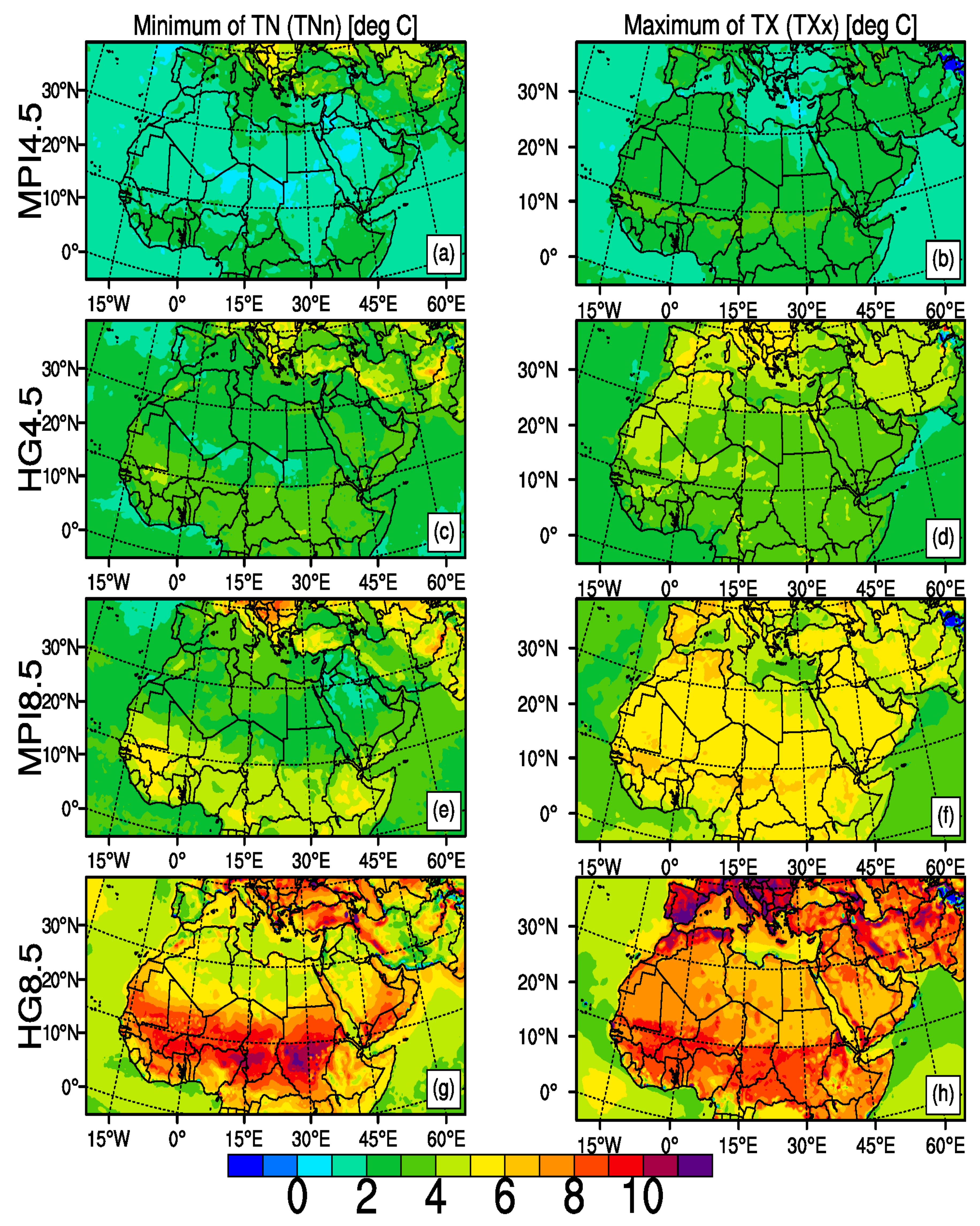
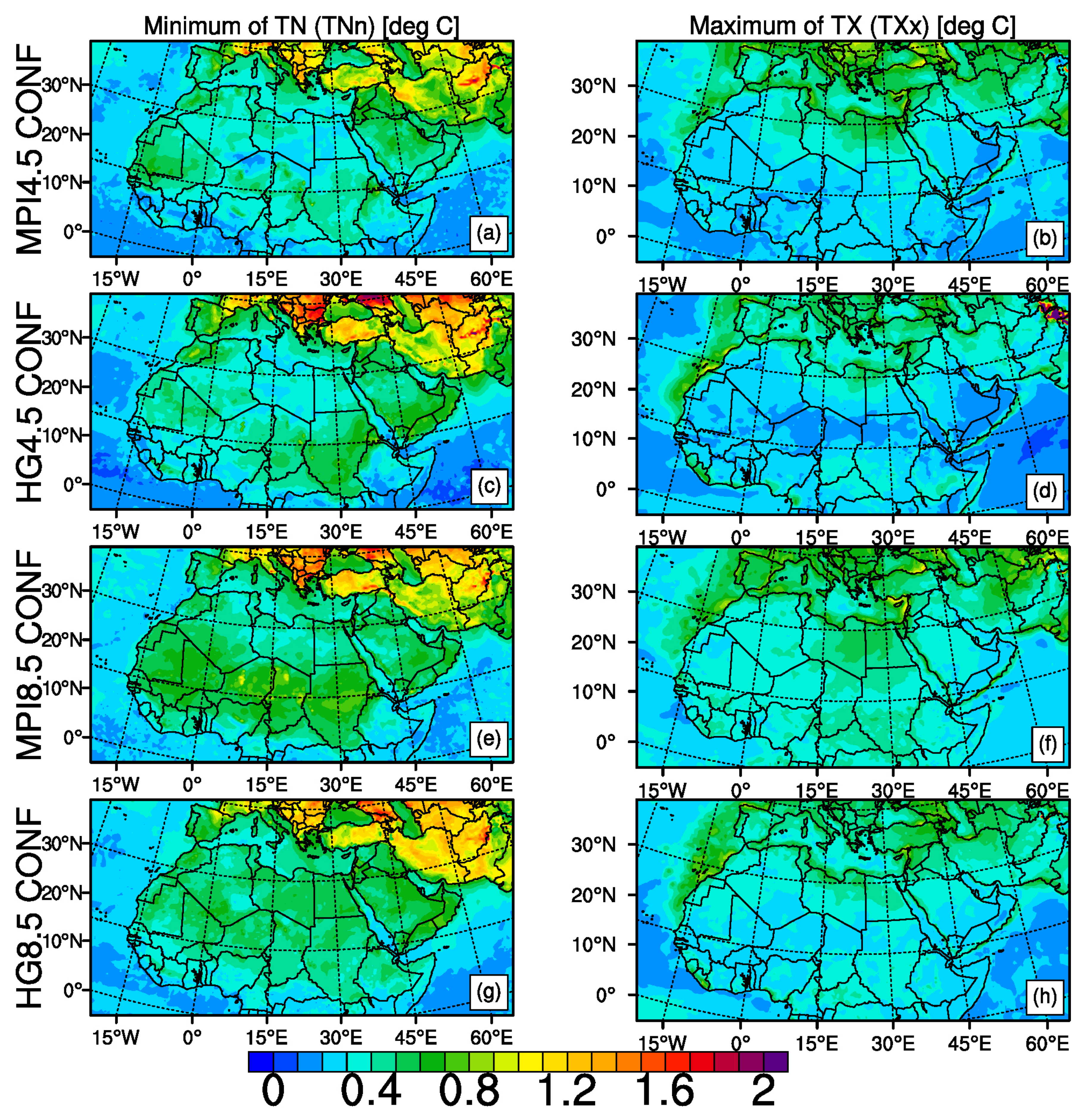
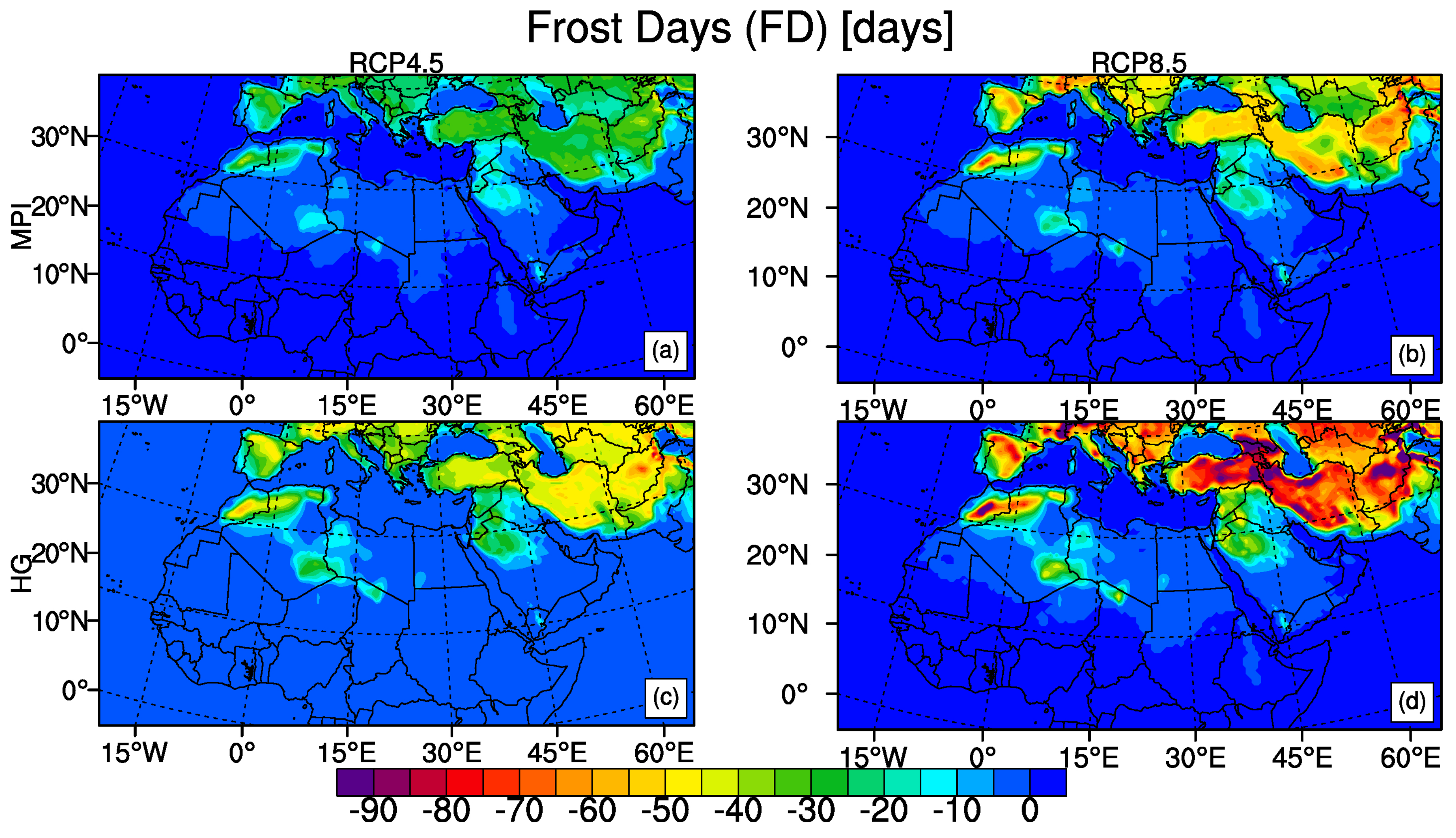
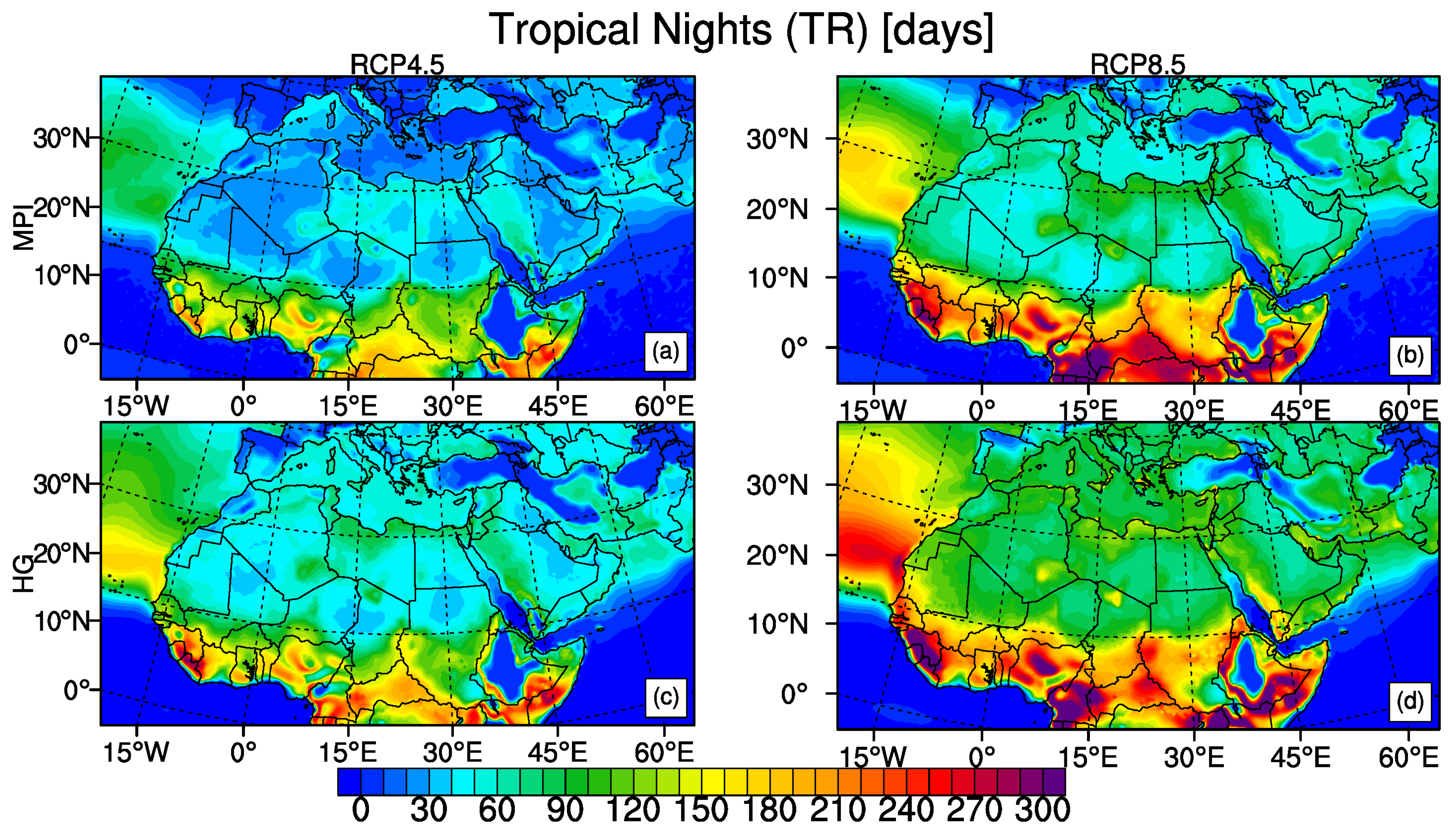
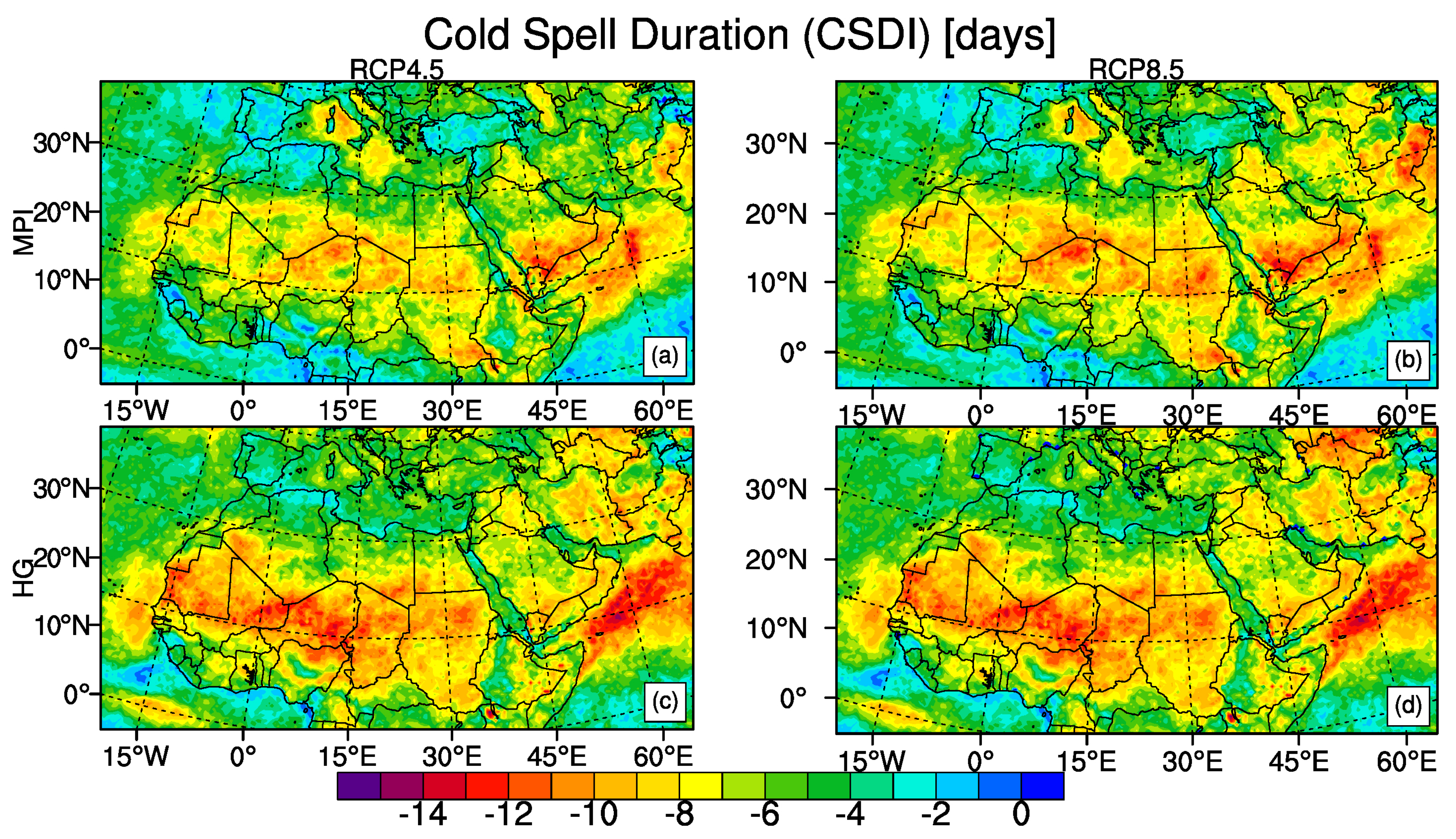
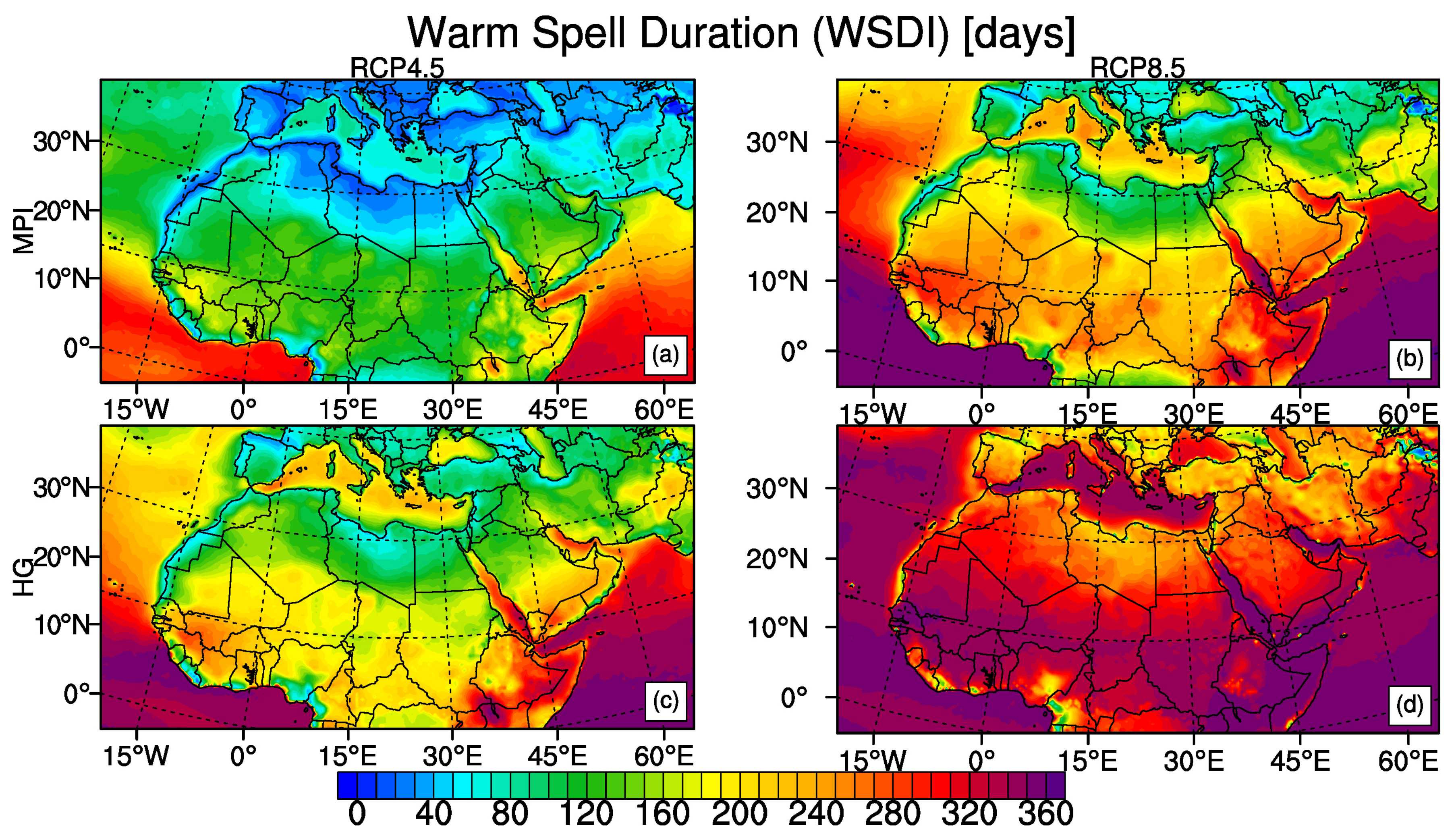

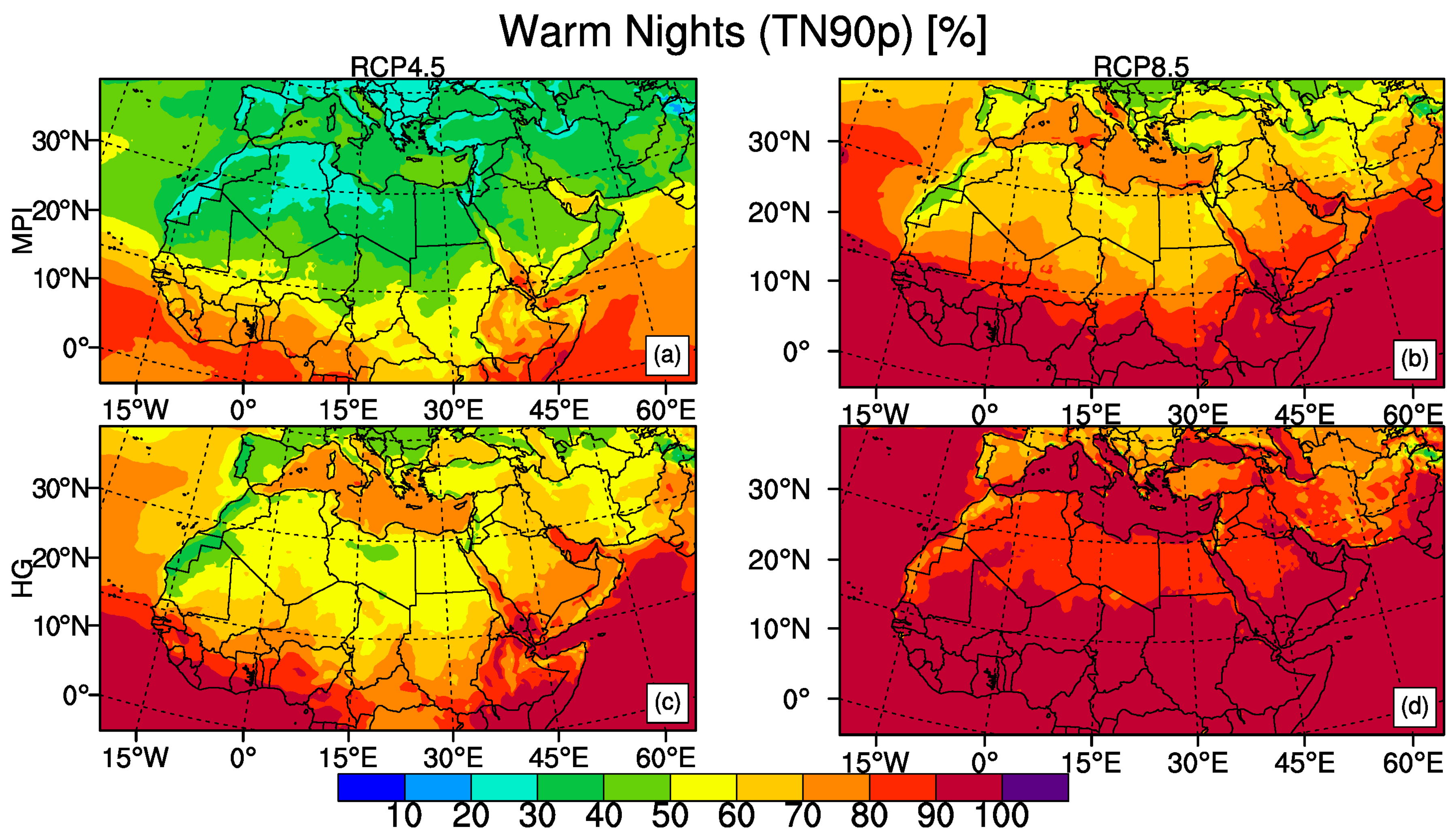
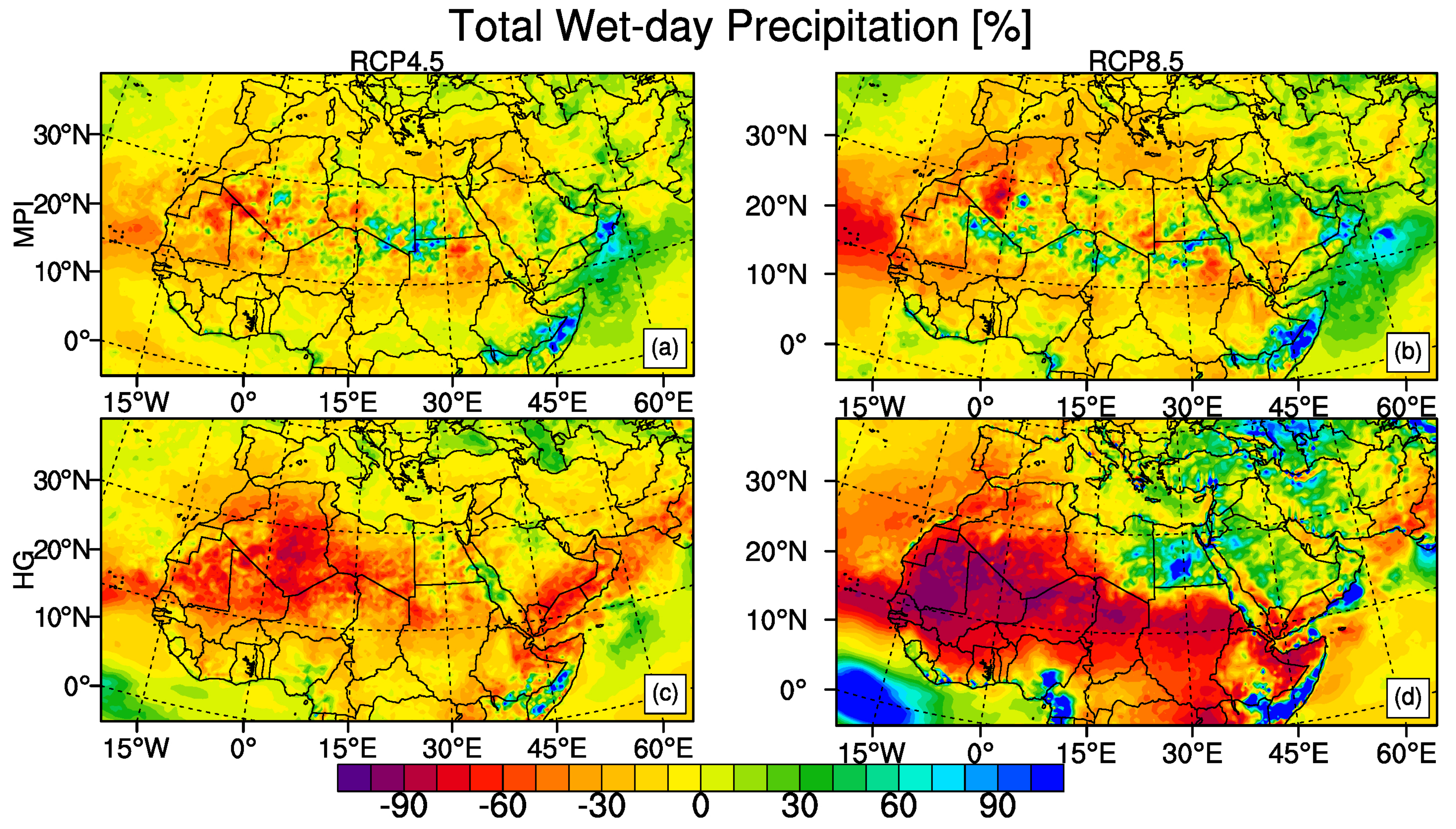

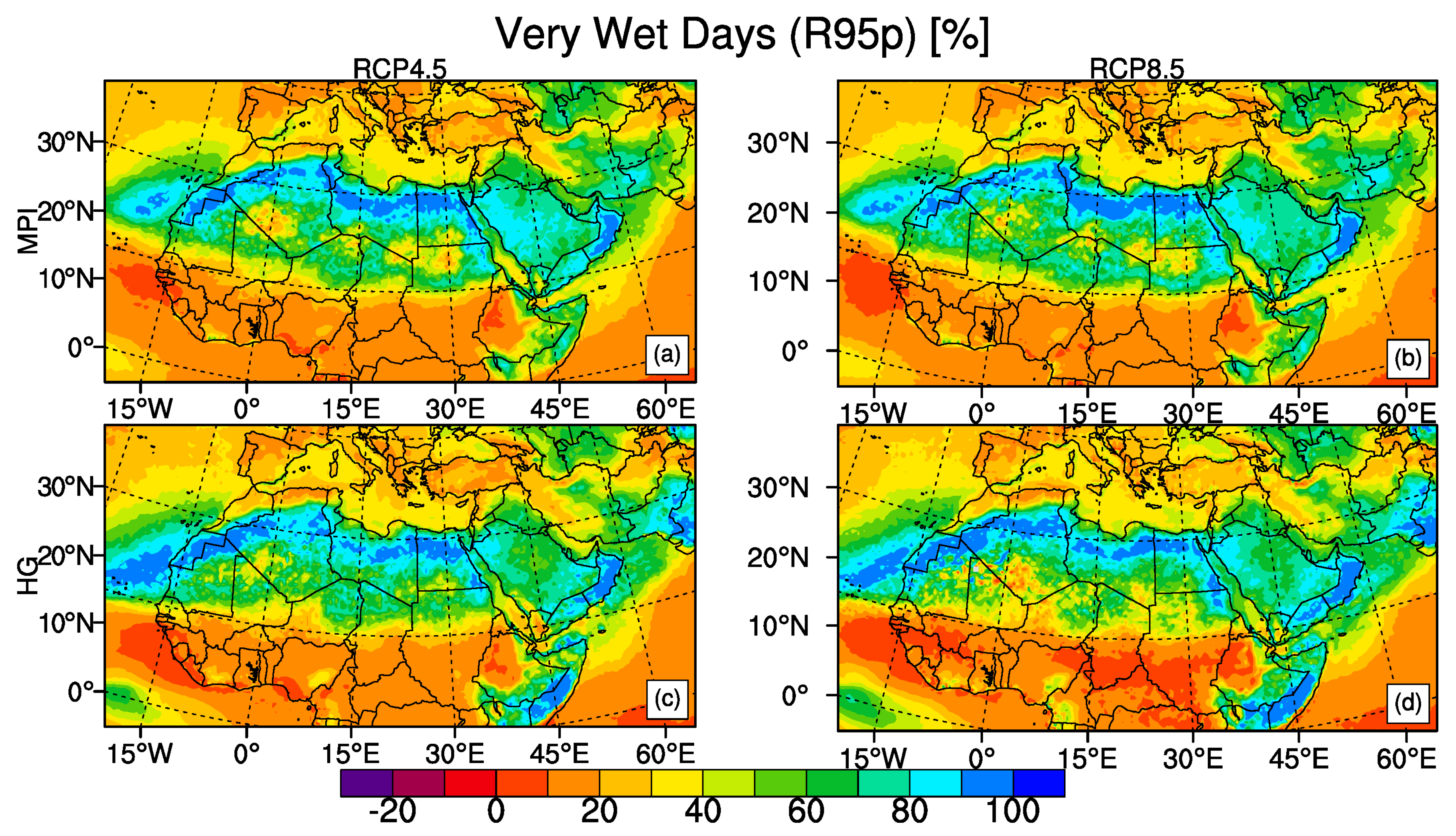
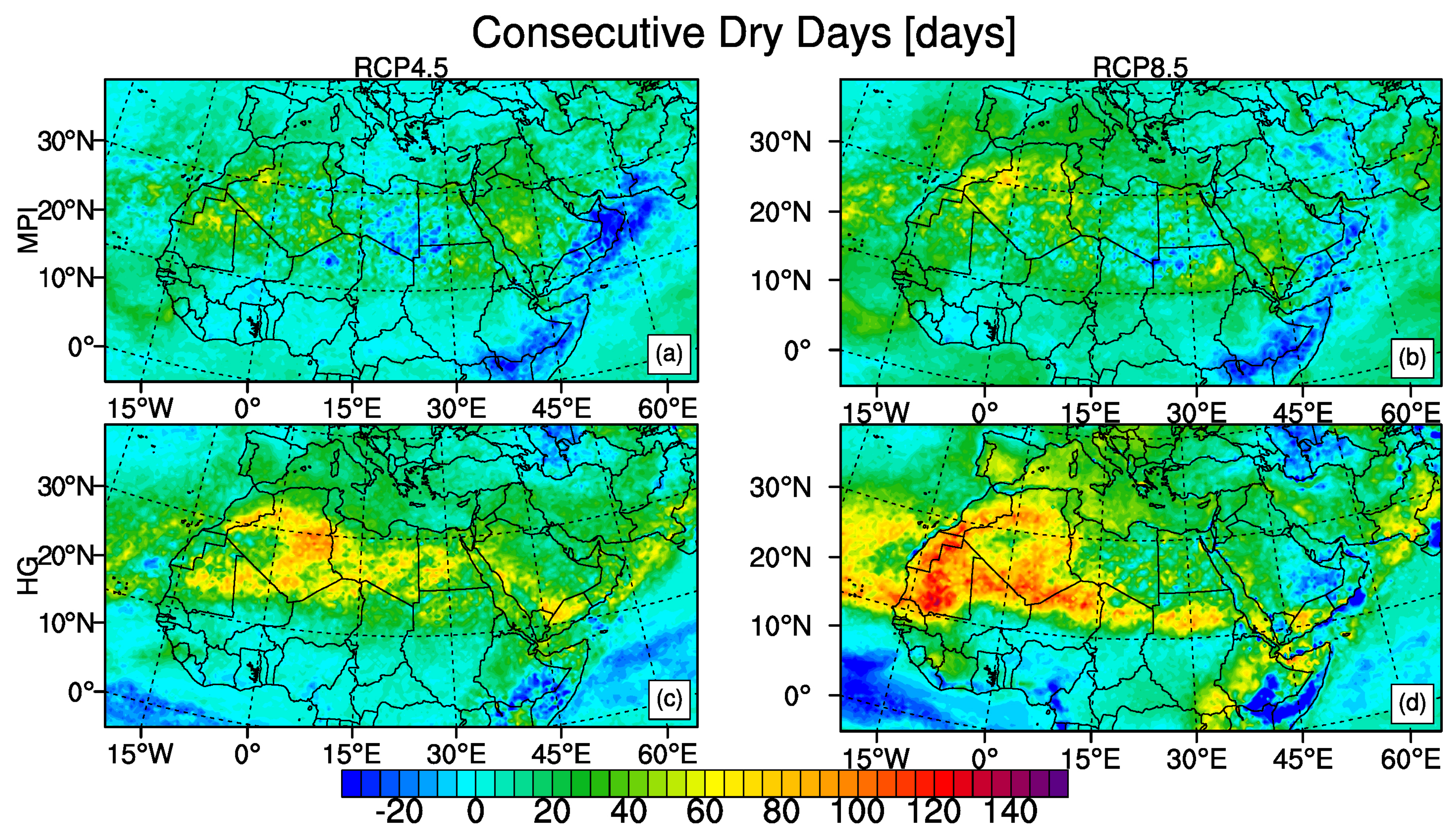
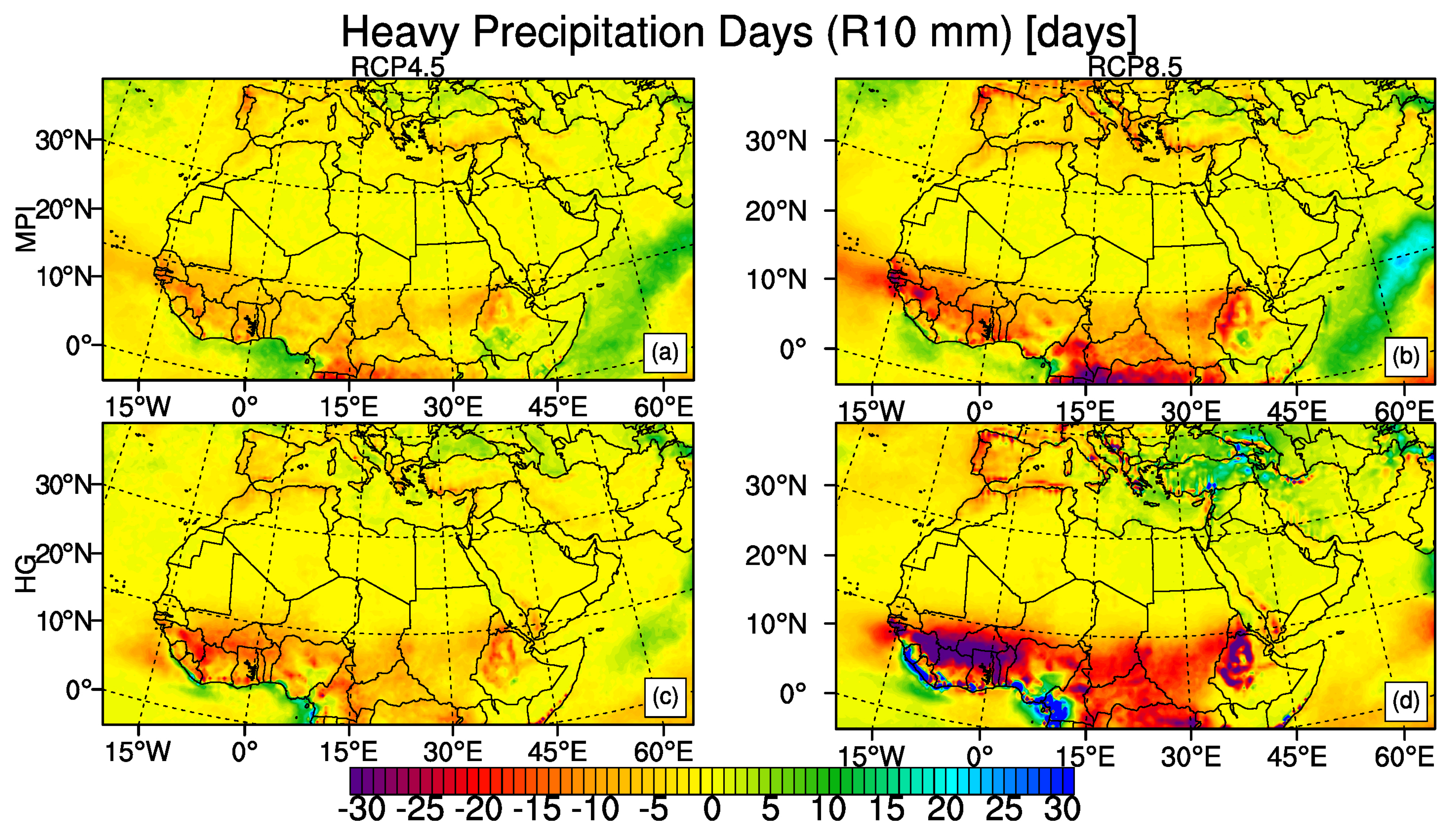
| Label | Index Name | Index Definition | Units |
|---|---|---|---|
| TN10p | Cold nights | be the daily minimum temperature on day i in period j and let be the calendar day 10th percentile centered on a 5 day window. The percentage of days in a year is determined where | % |
| TN90p | Warm nights | Let be the daily minimum temperature on a day i in period j and let be the calendar day 90th percentile centered on a 5 day window. The percentage of days in a year is determined where | % |
| WSDI | Warm spell duration | be the daily maximum temperature on a day i in period j and let be the calendar day 90th percentile centered on a 5 day window for the base period 1971–2000. Then the number of days per period is summed where in intervals of at least 6 consecutive days: | days |
| CSDI | Cold spell duration | be the daily minimum temperature on a day i in period j and let be the calendar day 10th percentile centered on a 5 day window for the base period 1971–2000. Then the number of days per period is summed where in intervals of at least 6 consecutive days: | days |
| TXx | Max TX | Let TXx be the daily maximum temperature in month k, period j. The maximum daily maximum temperature each month is then: | C |
| TNn | Min TN | Let TNn be the daily minimum temperature in month k, period j. The minimum daily minimum temperature each month is then: | C |
| FD | Frost days | Let TN be the daily minimum temperature on day i in period j. Count the number of days where C | days |
| TR | Tropical nights | Let TN be the daily minimum temperature on day i in period j. Count the number of days where C | days |
| R10mm | Heavy precipitation days | be the daily precipitation amount on day i in period j. Count the number of days where mm | days |
| CDD | Consecutive dry days | Let be the daily precipitation amount on day i in period j. Count the largest number of consecutive days where mm | days |
| R95p | Very wet days | Let be the daily precipitation amount on a wet day day w (PR ≥ 1 mm) in period i and let be the 95th percentile of precipitation on wet days in the 1970–2000 period. If W represents the number of wet days in the period, then: , where | mm |
| PRCPTOT | Total wet-day precipitation | Let be the daily precipitation amount on day i in period j. If I represents the number of days in j, then | mm |
| Mediterranean | Minimum of TN ( C) | Maximum of TX ( C) | Frost Days (days) | Tropical Nights (days) |
|---|---|---|---|---|
| MPI-ESM-MR RCP4.5 | 2.6 | 2.1 | −11.6 | 21.8 |
| HadGEM2-ES RCP4.5 | 3.2 | 4.4 | −17.8 | 46.4 |
| MPI-ESM-MR RCP8.5 | 3.8 | 5.1 | −19.2 | 49.7 |
| HadGEM2-ES RCP8.5 | 6.2 | 8.1 | −28.6 | 82.9 |
| Sahara | ||||
| MPI-ESM-MR RCP4.5 | 1.5 | 2.3 | −2.0 | 38.2 |
| HadGEM2-ES RCP4.5 | 2.6 | 3.7 | −4.3 | 56.3 |
| MPI-ESM-MR RCP8.5 | 2.9 | 5.1 | −2.9 | 69.9 |
| HadGEM2-ES RCP8.5 | 5.8 | 6.8 | −5.2 | 98.1 |
| East Africa | ||||
| MPI-ESM-MR RCP4.5 | 1.9 | 2.4 | −0.1 | 81.6 |
| HadGEM2-ES RCP4.5 | 3.0 | 3.4 | −0.1 | 97.8 |
| MPI-ESM-MR RCP8.5 | 4.0 | 5.1 | −0.1 | 140.4 |
| HadGEM2-ES RCP8.5 | 6.8 | 7.0 | −0.1 | 148.8 |
| West Africa | ||||
| MPI-ESM-MR RCP4.5 | 1.8 | 2.5 | 0.0 | 75.1 |
| HadGEM2-ES RCP4.5 | 3.0 | 3.2 | 0.0 | 83.0 |
| MPI-ESM-MR RCP8.5 | 4.0 | 5.0 | 0.0 | 120.4 |
| HadGEM2-ES RCP8.5 | 6.7 | 6.7 | 0.0 | 125.5 |
| Mediterranean | Cold Spell Duration (days) | Warm Spell Duration (days) | Cold Nights (%) | Warm Nights (%) |
|---|---|---|---|---|
| MPI-ESM-MR RCP4.5 | −4.5 | 43.7 | 2.5 | 33.5 |
| HadGEM2-ES RCP4.5 | −5.2 | 124.1 | 1.0 | 58.5 |
| MPI-ESM-MR RCP8.5 | −4.9 | 126.5 | 0.7 | 61.2 |
| HadGEM2-ES RCP8.5 | −5.4 | 260.4 | 0.2 | 84.1 |
| Sahara | ||||
| MPI-ESM-MR RCP4.5 | −7.0 | 92.7 | 2.1 | 39.7 |
| HadGEM2-ES RCP4.5 | −7.6 | 164.7 | 0.4 | 60.9 |
| MPI-ESM-MR RCP8.5 | −7.8 | 200.5 | 0.4 | 70.0 |
| HadGEM2-ES RCP8.5 | −7.6 | 301.1 | 0.1 | 90.0 |
| East Africa | ||||
| MPI-ESM-MR RCP4.5 | −6.0 | 156.5 | 0.6 | 66.6 |
| HadGEM2-ES RCP4.5 | −6.8 | 247.6 | 0.1 | 82.9 |
| MPI-ESM-MR RCP8.5 | −6.3 | 264.1 | 0.1 | 92.2 |
| HadGEM2-ES RCP8.5 | −6.8 | 341.4 | 0.0 | 98.8 |
| West Africa | ||||
| MPI-ESM-MR RCP4.5 | −4.7 | 174.2 | 0.4 | 67.7 |
| HadGEM2-ES RCP4.5 | −6.9 | 241.5 | 0.1 | 83.0 |
| MPI-ESM-MR RCP8.5 | −4.8 | 267.1 | 0.0 | 93.1 |
| HadGEM2-ES RCP8.5 | −6.9 | 329.1 | 0.0 | 98.8 |
| Mediterranean | Total Wet-Day | Very Wet Days (%) | Consecutive | Heavy Precipitation |
|---|---|---|---|---|
| Precipitation (%) | Dry Days (days) | Days (days) | ||
| MPI-ESM-MR RCP4.5 | −7.9 | 35.1 | 8.0 | −1.4 |
| HadGEM2-ES RCP4.5 | −7.7 | 35.5 | 18.4 | −0.9 |
| MPI-ESM-MR RCP8.5 | −15.1 | 35.7 | 15.5 | −3.0 |
| HadGEM2-ES RCP8.5 | −1.3 | 38.0 | 28.9 | −0.6 |
| Sahara | ||||
| MPI-ESM-MR RCP4.5 | −6.7 | 69.3 | 12.8 | −0.1 |
| HadGEM2-ES RCP4.5 | −33.7 | 69.6 | 38.3 | −0.5 |
| MPI-ESM-MR RCP8.5 | −2.1 | 69.8 | 16.8 | 0.0 |
| HadGEM2-ES RCP8.5 | −26.5 | 68.0 | 42.1 | −0.3 |
| East Africa | ||||
| MPI-ESM-MR RCP4.5 | 1.3 | 31.7 | 1.4 | −1.7 |
| HadGEM2-ES RCP4.5 | −20.8 | 33.8 | 10.1 | −4.2 |
| MPI-ESM-MR RCP8.5 | −2.5 | 32.4 | 5.6 | −5.6 |
| HadGEM2-ES RCP8.5 | −38.4 | 34.5 | 18.4 | −10.0 |
| West Africa | ||||
| MPI-ESM-MR RCP4.5 | −10.4 | 19.3 | 5.9 | −3.9 |
| HadGEM2-ES RCP4.5 | −13.6 | 21.1 | 3.8 | −4.2 |
| MPI-ESM-MR RCP8.5 | −12.4 | 20.5 | 12.9 | −7.1 |
| HadGEM2-ES RCP8.5 | −20.3 | 20.3 | 7.0 | −7.1 |
Publisher’s Note: MDPI stays neutral with regard to jurisdictional claims in published maps and institutional affiliations. |
© 2021 by the authors. Licensee MDPI, Basel, Switzerland. This article is an open access article distributed under the terms and conditions of the Creative Commons Attribution (CC BY) license (https://creativecommons.org/licenses/by/4.0/).
Share and Cite
Ozturk, T.; Saygili-Araci, F.S.; Kurnaz, M.L. Projected Changes in Extreme Temperature and Precipitation Indices Over CORDEX-MENA Domain. Atmosphere 2021, 12, 622. https://doi.org/10.3390/atmos12050622
Ozturk T, Saygili-Araci FS, Kurnaz ML. Projected Changes in Extreme Temperature and Precipitation Indices Over CORDEX-MENA Domain. Atmosphere. 2021; 12(5):622. https://doi.org/10.3390/atmos12050622
Chicago/Turabian StyleOzturk, Tugba, F. Sibel Saygili-Araci, and M. Levent Kurnaz. 2021. "Projected Changes in Extreme Temperature and Precipitation Indices Over CORDEX-MENA Domain" Atmosphere 12, no. 5: 622. https://doi.org/10.3390/atmos12050622
APA StyleOzturk, T., Saygili-Araci, F. S., & Kurnaz, M. L. (2021). Projected Changes in Extreme Temperature and Precipitation Indices Over CORDEX-MENA Domain. Atmosphere, 12(5), 622. https://doi.org/10.3390/atmos12050622







